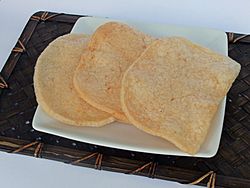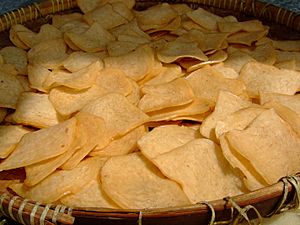Prawn cracker facts for kids

Krupuk udang, Indonesian prawn cracker
|
|
| Course | Snack |
|---|---|
| Place of origin | Indonesia and Malaysia |
| Region or state | Southeast Asia |
| Serving temperature | Room temperature |
| Main ingredients | Deep fried dried starch and other ingredients, the most popular is Prawn |
| Variations | Different variations according to ingredients |
Prawn crackers (Indonesian: krupuk udang) are a yummy, crunchy snack. They are made from starch (like flour) and prawns (small sea creatures, like shrimp). These snacks are deep-fried until they puff up!
You'll find prawn crackers a lot in Southeast Asia. They are very popular in countries like Indonesia and Malaysia. Other places in Asia also have similar tasty snacks. For example, Japan has kappa ebisen and Korea has saeukkang.
Contents
The Story of Prawn Crackers
Prawn crackers have a long history! Experts say that krupuk (which means crackers) first appeared in Java, Indonesia. This was way back in the 9th or 10th century.
Early crackers were made from things like cow or buffalo skin. These are still eaten today as krupuk kulit. Over time, people started making crackers from different ingredients. Fish and prawns became very popular.
Crackers then spread across the islands of Indonesia. They also traveled to the Malay Peninsula. People living near the coast used extra fish and prawns to make these delicious snacks.
A British chef named Will Meyrick says prawn crackers came to the Malay Peninsula in the 16th century. A story says that people used leftover prawn heads from a big meal to make the first prawn crackers.
Around the 1800s, prawn crackers became known in other countries. This happened when the Dutch East Indies (now Indonesia) was a colony. The Dutch people enjoyed them so much that they brought the idea of eating prawn crackers back to the Netherlands.
How Prawn Crackers Are Made
Making prawn crackers starts with mixing prawns, tapioca flour (a type of starch), and water. This mixture is then rolled out flat and steamed. After steaming, it's sliced into small pieces.
To make them super crispy, these raw cracker pieces are usually dried in the sun. This removes all the moisture. Once they are dry, they are ready to be deep-fried in very hot oil.
When they hit the hot oil, something amazing happens! In just a few seconds, the small, hard pieces expand. They puff up into big, fluffy crackers. It's a bit like how popcorn pops! This happens because the water inside turns into steam and makes the cracker expand.
Prawn crackers are best eaten soon after they are fried. If they sit out for too long, they can get soft and chewy. Keeping them in a sealed container helps them stay crispy.
The best quality prawn crackers taste great even without extra flavorings. Fried prawn crackers can stay fresh for a few months in a sealed container.
You can also cook most prawn crackers in a microwave oven. A few pieces can be ready in less than a minute! They puff up like they do when fried. This method is faster and less messy for small amounts. However, they might have a stronger shrimp smell and can get soft quicker.
Where to Find Prawn Crackers
You can buy packets of unfried prawn crackers in many Asian grocery stores. In countries like the Netherlands, Australia, and the United Kingdom, you can also find them in regular supermarkets.
Sometimes, when you order takeaway food from East or Southeast Asian restaurants in places like the UK or Australia, they might even give you prawn crackers for free!
Different Kinds of Prawn Crackers
Southeast Asian Styles
In Indonesia, prawn crackers are called krupuk udang. But krupuk is a general word for many types of crackers there. Indonesia has a huge variety of crackers! Krupuk udang is very common everywhere in Indonesia.
Many raw krupuk udang sold in packs need to be sun-dried before you fry them at home. Fishing towns like Sidoarjo and Cirebon in Indonesia are famous for making lots of krupuk udang.
In Malaysia, prawn crackers are called keropok. They are a very popular snack. People often serve them during special celebrations like Chinese New Year and Hari Raya.
In the Philippines, they are called kropek. They are usually eaten as a snack or as an appetizer with drinks. People often dip kropek in spicy vinegar sauces.
In Vietnam, they have bánh phồng tôm. This traditional snack is made from ground shrimp, tapioca flour, and spices. They are often shaped like ovals to help scoop up salads. There's also a version called bánh phồng nấm that tastes like shiitake or straw mushrooms.
Chinese Style
Chinese prawn crackers often come in different colors like white, pink, green, and blue. They tend to be lighter and not spicy. You can find them in supermarkets in China, but they are not as common in restaurants.
In some countries like Australia and the UK, prawn crackers are often served with takeaway Chinese food. They are also sometimes served with roasted chicken dishes.
These crackers often use cornstarch to hold them together. This can make them taste a bit more like noodles than potato chips. They are usually sold uncooked, so they store well.
Dutch Style
Because of their history with Indonesia, the Dutch know a lot about Indonesian foods. You can find many kinds of kroepoek (the Dutch word for krupuk) in Dutch-Indonesian shops called toko. Prawn crackers are also sold in many big supermarkets. They are a common side dish in Indonesian restaurants in the Netherlands.
Japanese Prawn Crackers
Japanese prawn crackers are a bit different. They often use rice flour as a binding agent. This makes their texture generally softer and their taste less strong than the Chinese type.
Korean Prawn Crackers
Korean prawn crackers often contain wheat flour and soy sauce. This gives them an extra savory flavor. If you like crispy, bready crackers, these might be for you!
Thai Prawn Crackers
Thai shrimp chips often have a sweet Thai chili flavor. They are also made with traditional tapioca flour. You can choose which type of prawn cracker you like best based on its flavor, texture, and how it's made!
Images for kids
-
Assorted types of Kroepoek sold in Indo Toko in Amsterdam, Netherlands





